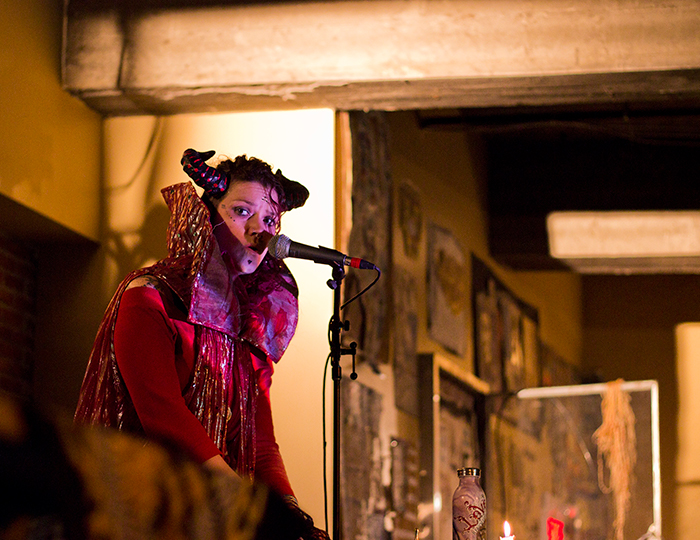With increasing museum and gallery admission fees in more formal spaces, many spectators look to smaller events to discover artists, pushing the envelope of what it means to make art. From Jan. 11 to 14, Odd Stumble, in collaboration with Théâtre Rialto, organized Archipelago, a collection of interdisciplinary performances and art installations. With an emphasis on collaboration and improvisation, visitors embarked on an interactive experience with a map of the theatre as a guide. Traveling through the different areas of the venue, it was easy to immerse oneself into the various performances, regardless of the medium.
On the main stage, Nicolas Royer Artuso of Thought Experiment Productions performed “4’33 in Baghdad,” presenting his reflections on important socio-political themes. Inspired by John Cage’s “4’33,” he guided his audience to listen to the silence within the theatre. As video clips of a Baghdad neighbourhood flash onto the screen, he announced a festival celebration accompanied by fireworks. Sounds of explosions filled the space, with the neighbourhood being demolished right in front of us. Conflating aesthetics and politics, Artuso left audiences with the simple question: “How can we stay silent?”
In the adjacent room, Aquil Virani’s Sit with me invites the audience to sit in front of his developing portrait series, CelebrateHer. Accompanying the portrait was a soundscape in which a woman speaks to the audience, bringing the portrait to life with her own words.
Théâtre Rialto’s beauty is overwhelming. An operating “theatre palace” until the 1990s, the building itself was modelled after the Paris Opera House, distinct for its neo-baroque interior design. Leaving no space unexplored, I ventured into the restroom. Stepping inside, I entered artmaker Jessica Rae’s The Green Room, which visualized a dream-like world with puppets and bright colours, establishing a certain slight uneasiness as schools of fish jumped from sink to sink. In the adjacent restroom, multidisciplinary artist Naomi Aldrich presented Trace (72): “Evidence or an indication of the former presence or existence of something,” a performance exploring mark making. At first glance, Aldrich’s positioning in between the bathroom stalls seemed off-putting. As she reapplied paint on her feet and hands, she began to count along with the voice that booms above the listener. Within this physical narrative, the passing of time, as well as her repetition of the markings, reinforced her performance.
These performances appeared to be independent of one another, but all somehow made the viewer think about how to interact with the various installations. In the Piccolo room downstairs, Maggie Winston began her performance of Wolf Tea, combining handmade masks, puppets, physical theatre, digital projections, and soundscapes. Combining the mundane with fantasy, Winston visualized how they intertwine in this constructed reality. Across the room, Carlo Polidoro Lopez presented several artworks, visualizing complex socio-political experiences. In a secret staircase, he illustrated the defining moment of his life: Witnessing the deaths of several family members at a young age. Using various discarded materials, Lopez’s artworks demonstrated that you don’t need much to make beautiful art.
A definite highlight of the art funhouse was KyAzMa, an electronic-bass-folk hybrid, creating a cinematic sonic experience like no other. Members William Moon and Christina Enigma cited numerous influences for this project, such as Radiohead, Boards of Canada, and Fleetwood Mac. The band filled the room with a healing energy, providing a needed calm-down within Archipelago’s sensory overload.
Unlike a traditional trip to a gallery, Odd Stumble’s art extravaganza demanded the viewer to actively participate in experiencing the art. Whether it was juxtaposing the mundane with the violent or exploring the healing potential of vocal harmonies, Archipelago reflected a refusal to stay silent, and reworked the definition of how art can be experienced by the everyday viewer.









